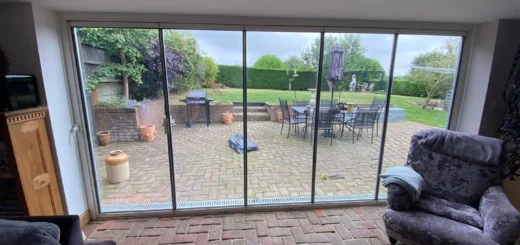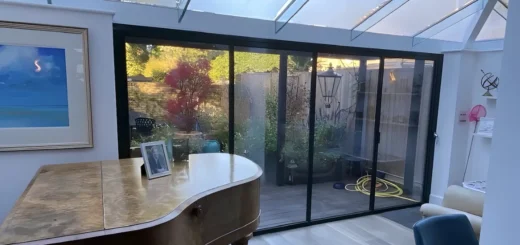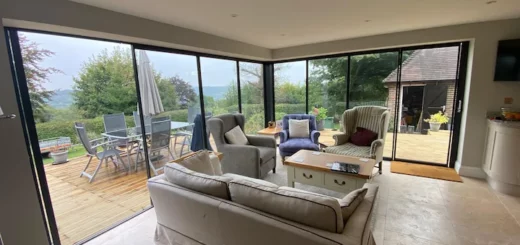Guide to Choosing Internal Aluminium Bifold Doors Well
Table of Contents
Core Features of Internal Aluminium Bifold Doors
Internal aluminium bifold doors bring together practical design and modern engineering, making them ideal for creating flexible spaces within your home.
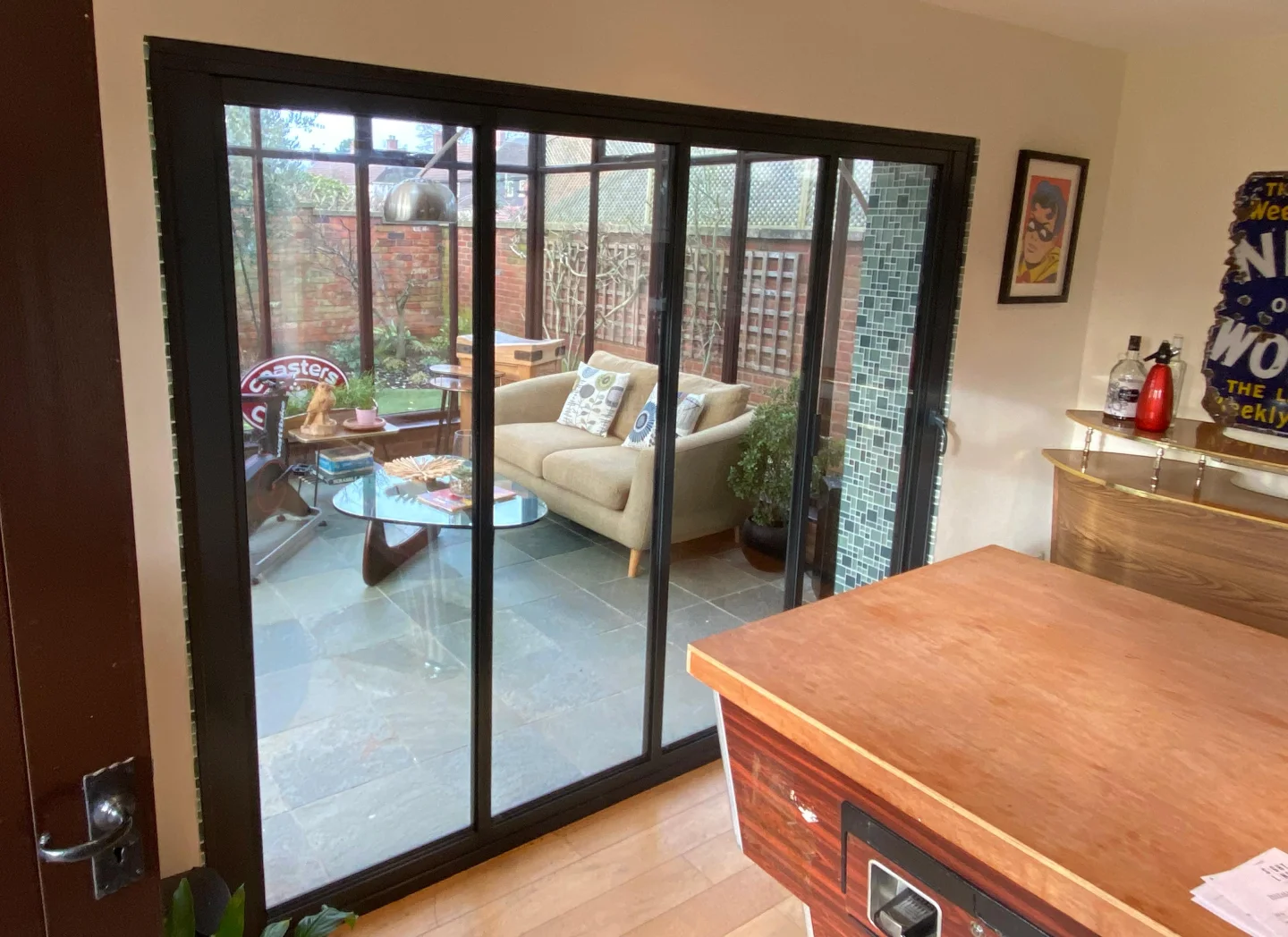
Slim Sight Lines and Visual Impact
Aluminium’s remarkable strength permits far slimmer frames than traditional timber or uPVC, with modern internal door systems requiring as little as 50mm of visible frame between panels. These minimal sight lines make internal aluminium bifold doors particularly striking when used to divide larger rooms.
Powder-coated aluminium frames provide a clean, crisp outline that draws the eye without dominating the space.
The reduced bulk of aluminium frames allows more glass area in each panel, flooding adjoining spaces with natural light. Modern folding doors crafted from aluminium achieve this balance of strength and elegance through advanced alloy composition, enabling taller and wider glass panels than ever before. Manufacturers can now produce bi-fold doors with impressively slim frames while maintaining the structural integrity needed for daily use.
Structural Capabilities for Large Openings
Bi-folding doors made from aluminium can span wider openings than other materials thanks to the metal’s inherent rigidity. The strength-to-weight ratio of aluminium interior bifold doors means less structural support is needed above the opening, simplifying installation in existing homes. Each panel maintains its shape over time without sagging or warping, ensuring smooth operation year after year.
Wide open plan living spaces benefit particularly from aluminium’s structural advantages. The material’s stability allows for taller door heights without requiring additional reinforcement, creating an impressive sense of scale. Even in substantial openings, the doors remain light enough to fold and slide with minimal effort.
Glass Options and Light Flow
Various glazing options complement aluminium frames, from standard clear glass to specialised acoustic panels for noise reduction between rooms. Double-glazed units fit comfortably within the frame profiles, providing improved sound insulation when needed. Toughened safety glass comes as standard in all panels, meeting building regulations while providing peace of mind in busy family spaces.
The slim profile of aluminium allows for larger glass panels, helping natural light reach deeper into your home. Obscured or decorative glass options work particularly well with these minimal frames, creating subtle divisions between spaces without blocking light completely. The clean lines of aluminium frames draw attention to the glass itself, making feature glazing more impactful in your interior design scheme.
Technical Specifications
The engineering behind internal aluminium bifold doors combines precision manufacturing with robust materials. High-grade aluminium alloys provide excellent dimensional stability, while precision-engineered running gear ensures reliable operation. Multi-point locking systems integrated into the frame profiles offer secure closure when needed, while magnetic catches hold panels neatly in place when folded back.
Planning Your Internal Aluminium Bifold Door Design
Internal aluminium bifold doors require careful planning to work perfectly in your space. From choosing the right configuration to selecting finishes, each decision shapes how the doors will look and work in your home.
Door Configurations That Work
The way your doors fold makes a real difference to how you’ll use the space. Internal folding doors can split evenly from the centre or stack to one side, depending on your room layout. A three-panel design works well for smaller openings, while larger spaces might need five or more panels for balanced proportions. Some homeowners opt for a single access panel that operates like a normal door when the full opening isn’t needed.
Stacking direction deserves special attention when planning internal bi-fold doors. The panels must have space to fold back without blocking walkways or bumping into furniture. Most internal aluminium bifold doors need about 100mm of space per panel in their stacked position. The tracking system determines how the panels move and stack, with top-hung systems particularly suited to internal applications thanks to their clean floor profile.
Hardware and Track Systems
Choosing the right hardware makes all the difference to how internal aluminium bifold doors operate day to day. Top-hung systems eliminate the need for a bottom track, creating a flush threshold between rooms. The running gear quality directly influences how smoothly the doors slide and fold. Premium stainless steel rollers and bearings provide reliable, quiet operation over many years.
Handle designs range from minimal finger pulls to full-length ladder handles. Internal doors typically use simpler hardware than external sets since they don’t need complex locking mechanisms. Magnetic catches hold the doors neatly in their closed position, while intermediate panels often feature discreet drop bolts for stability when closed.
Advanced Operating Systems
Top-hung folding door sets use precisely engineered aluminium tracks with multiple roller carriages per panel. This spreads the weight evenly and ensures consistent operation. Some systems incorporate soft-close mechanisms similar to kitchen cabinets, preventing the doors from slamming and protecting fingers.
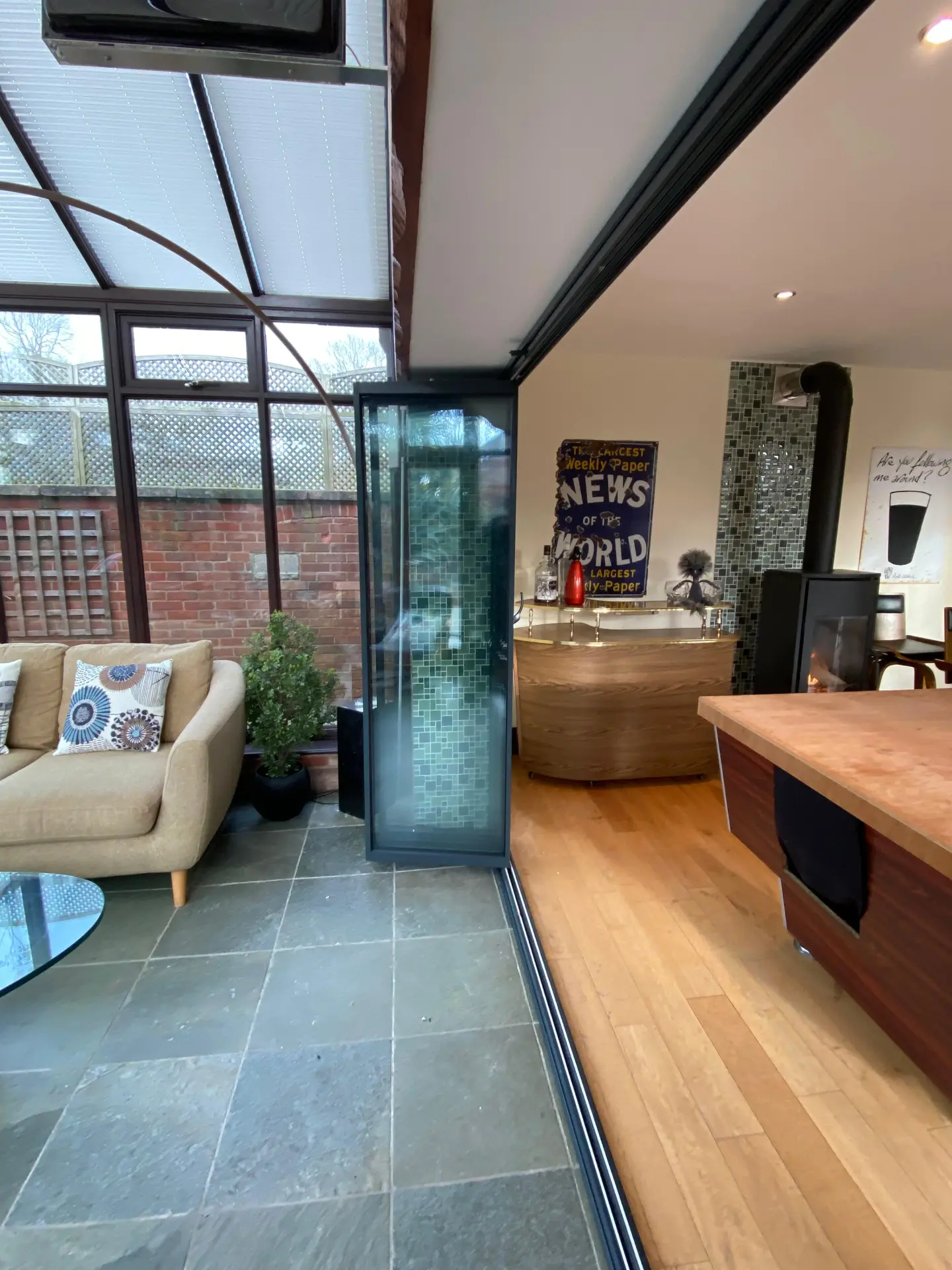
Colour and Finish Selection
Powder coated aluminium doors offer extensive colour options beyond standard white or grey. Dark anthracite creates striking contrast against light walls, while bronze or copper-effect finishes add warmth to contemporary interiors. The powder coating process ensures the colour remains stable and resists scratches, unlike painted finishes that might chip over time.
Metallic finishes can completely change how aluminium internal bifold doors interact with light throughout the day. A subtle champagne finish might appear almost white in bright daylight but take on a warm glow in evening light.
Some manufacturers offer dual colour options, allowing different finishes on each side to coordinate with adjoining rooms.
Textured powder coatings provide an alternative to smooth finishes, offering improved durability in high-traffic areas. These finishes hide minor marks and fingerprints better than gloss surfaces, making them practical for family homes. The texture depth varies between manufacturers, from fine grain to more pronounced patterns that add visual interest to the frames.
Material and Texture Combinations
The clean lines of aluminium frames work particularly well alongside raw materials like exposed brick or polished concrete. Natural wood flooring creates pleasing contrast with internal aluminium bifold doors, especially when the grain runs perpendicular to the door panels. The metal frames can pick up and reflect subtle tones from surrounding materials, helping tie the overall design together.
Glass specification plays a vital part in the final look. Clear glass increases light flow, while frosted or fluted options provide privacy without blocking light completely. Reeded glass adds vertical texture that complements the slim aluminium frames, creating subtle shadow play as light moves across the surface. Some manufacturers offer integrated blinds within the glass units, though these systems tend to require thicker frames.
Room By Room Internal Aluminium Bifold Door Ideas
Internal aluminium bifold doors offer unique opportunities in each room of your house, with different configurations and glass types suiting various spaces and purposes.
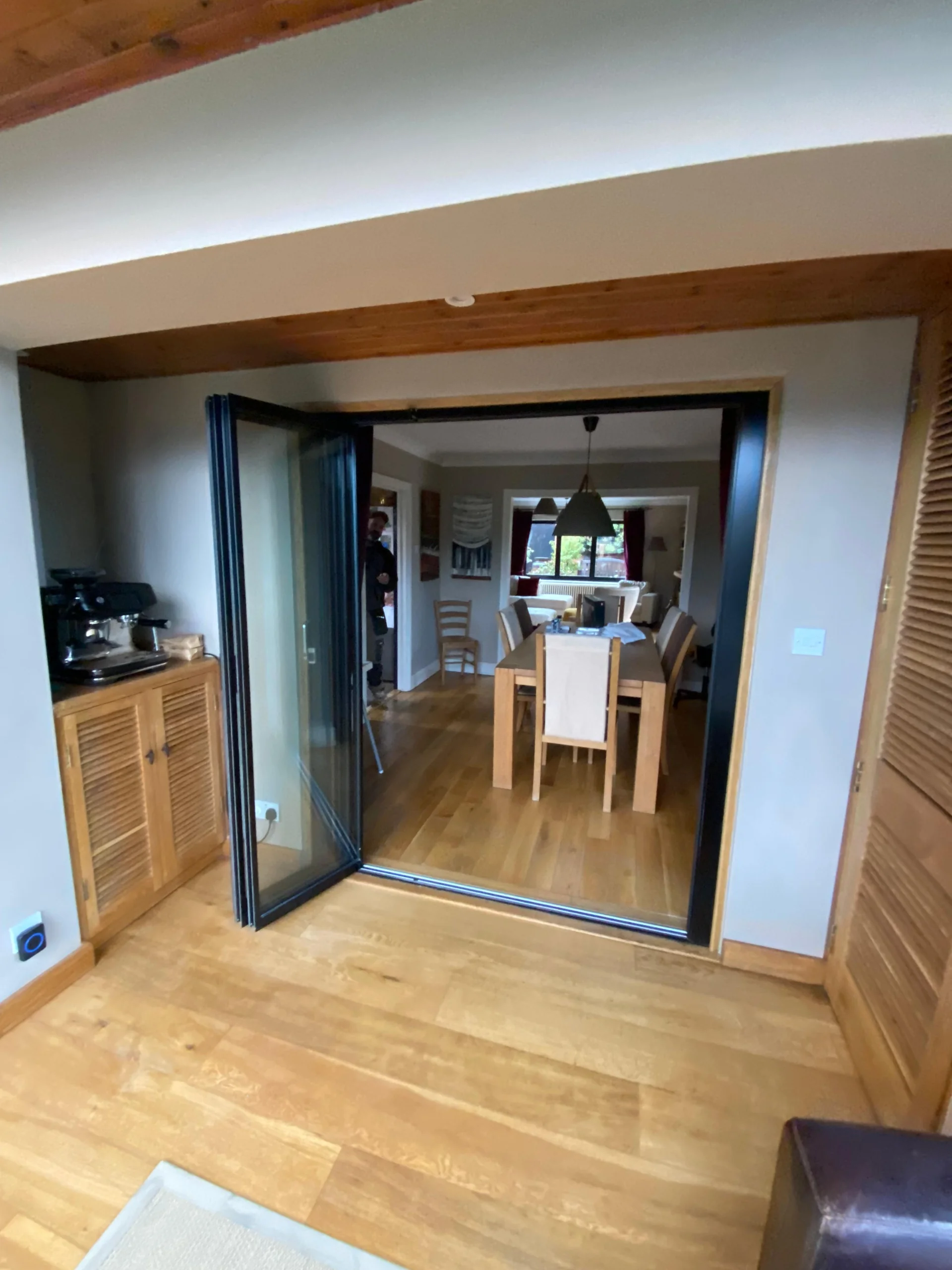
Kitchen and Dining Spaces
Large bifold doors between kitchen and dining areas let you control cooking smells and noise while maintaining visual connection between spaces. A three-panel configuration often works well here, with panels stacking to one side to avoid blocking thoroughfares. Clear glass helps parents keep an eye on children while cooking, though reeded or frosted options provide more separation when needed.
Creating zones within open-plan spaces becomes simple with internal folding doors. The kitchen can remain separate during dinner parties, then open fully for casual family meals. Glass panels reflect light around the space, making smaller kitchens feel more spacious without sacrificing practical separation when needed. Darker frame finishes often work particularly well against pale kitchen units, creating a striking visual divide.
Internal aluminium bifold doors prove especially useful in kitchen extensions, where they can divide the original kitchen from newer living spaces. This helps manage temperature differences between old and new sections of the house while still allowing easy movement between areas. The slim frames don’t compete with kitchen design features, instead providing subtle division that complements modern appliances and fixtures.
Home Offices
Aluminium internal bifold doors excel at creating flexible workspaces within living areas. Sound-dampening glass options reduce noise transfer, helping with concentration during video calls. The doors can fold completely away during family time, yet close quickly when privacy becomes necessary.
Workspace Integration
Modern home offices benefit from bi-fold doors in several ways:
- Sound reduction with acoustic glass
- Full access when doors are stacked
- Quick privacy for video meetings
- Light sharing between spaces
- Temperature control between rooms
Living Areas and Family Rooms
Living spaces divided by internal aluminium bifold doors gain flexibility without losing their open feel. Parents can separate children’s play areas from adult spaces when needed, then open everything up for family gatherings. The reflective qualities of aluminium frames help bounce natural light deeper into the space, particularly useful in darker winter months.
Frame colours can define different zones while maintaining visual harmony. Dark frames create bold statements in modern interiors, while bronze finishes add warmth to traditional spaces. Some homeowners choose to match their internal aluminium bifold doors to existing window frames for consistency throughout the house.
Multiple door sets can work together to create adaptable spaces. A U-shaped layout might use two sets of internal aluminium bifold doors to allow various room combinations, perfect for modern family living where space needs change throughout the day. This approach works particularly well in homes where formal and informal living areas adjoin.
Bedroom and Dressing Areas
Walk-in wardrobes and en-suite bathrooms become more practical with internal aluminium bifold doors providing wide access when needed. Obscured glass maintains privacy while allowing natural light to flow between spaces. The slim profile of aluminium frames creates elegant divisions without the bulk of traditional door frames.
Morning routines become easier when dressing areas can be fully opened to the bedroom. The doors stack neatly against the wall, temporarily creating one larger space. Some homeowners opt for mirrored panels, doubling as full-length mirrors when closed while reflecting light around the room.
Dressing rooms benefit from the ability to close off completely or open fully as needed. The clean lines of aluminium frames complement built-in storage systems, creating a cohesive look. When using internal aluminium bifold doors in bedrooms, extra attention to roller quality ensures quiet operation for undisturbed sleep.
Style Guide for Internal Aluminium Bifold Doors
Glass interior doors made from aluminium require thoughtful styling to work harmoniously with your existing interior design. Rather than treating them as simple partitions, view them as architectural features that can define and shape your living space.
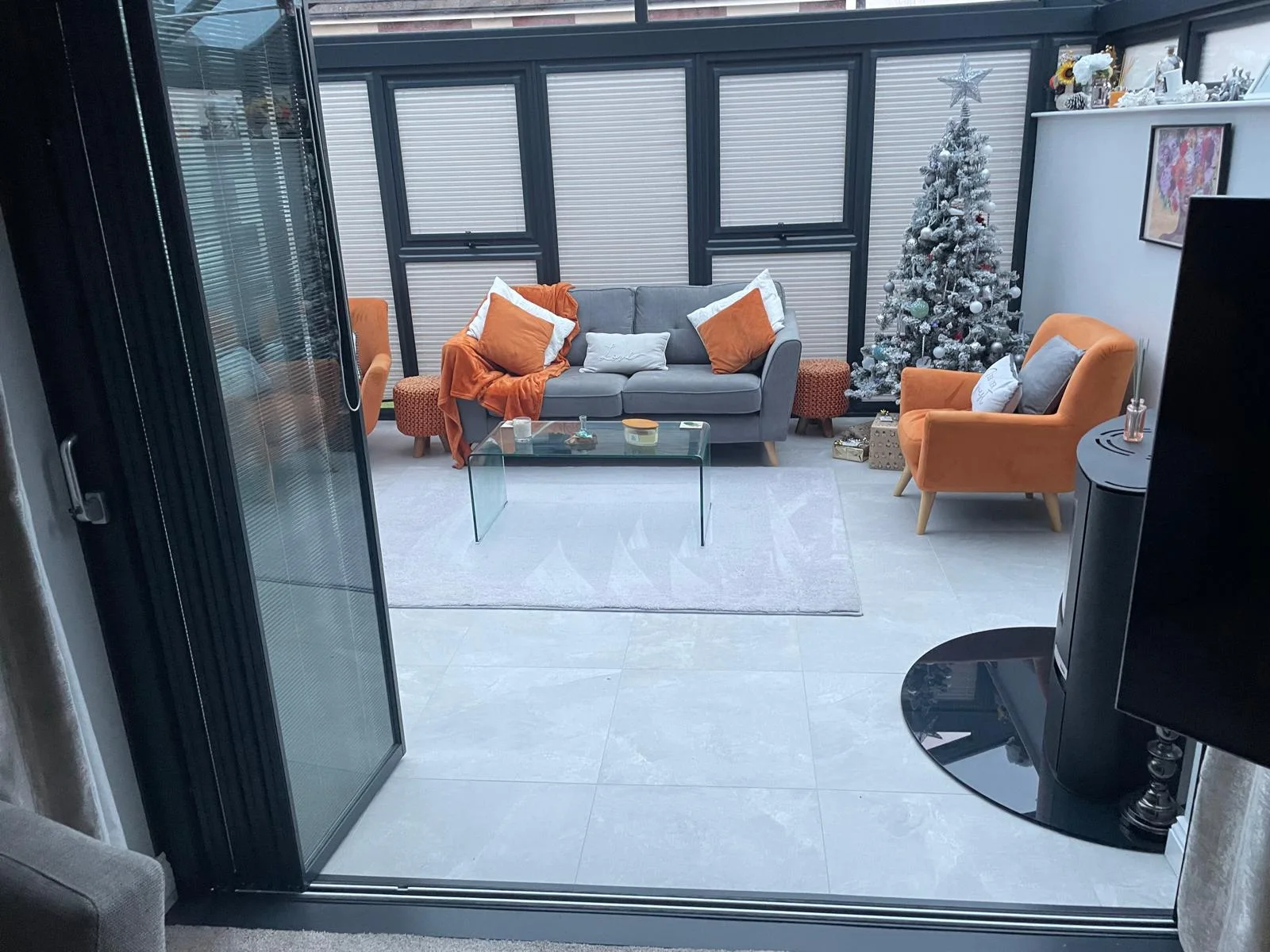
Modern Minimalist Approaches
Internal aluminium bifold doors shine in minimalist settings where their clean lines become part of the overall design language. The slim frames pair naturally with tiled floors, particularly large-format porcelain that creates uninterrupted sight lines. Pale walls in whites or soft greys let the metal frames stand out as deliberate design elements rather than mere utilities.
Raw concrete surfaces provide striking backdrops for aluminium frames, especially in converted industrial spaces.
The metallic finish picks up and reflects subtle variations in the concrete’s texture, creating an interplay between rough and smooth surfaces. This industrial-inspired aesthetic works particularly well with black or graphite frame finishes.
Made to measure folding doors allow precise fitting to unusual spaces, maintaining crisp architectural lines without awkward infill panels. Floor-to-ceiling installations draw the eye upward, emphasising room height while avoiding visual clutter. Some designers specify recessed tracks in the ceiling to achieve an even cleaner look.
Industrial Design Elements
Metal finishes beyond standard silver add depth to industrial-style interiors. Bronze or copper-effect powder coatings bring warmth to spaces with exposed brick or steel beams. Internal aluminium room dividers in dark finishes create bold geometric patterns when folded, adding visual interest even when closed.
Texture and Material Contrasts
Internal aluminium bifold doors work particularly well alongside textured wall finishes like venetian plaster or grasscloth wallpaper. The contrast between smooth metal and tactile surfaces creates visual and textural interest. Natural materials like wood or stone flooring ground the modern appearance of aluminium internal bifold doors, preventing spaces from feeling too clinical.
Fabric choices in adjoining rooms can soften the appearance of metal frames. Rich textiles and deep pile carpets balance the hard surfaces of bi-folding doors, while still maintaining a contemporary feel. Wall panelling installed alongside internal doors adds architectural detail without competing with the clean lines of aluminium frames.
Contemporary Colour Schemes
Aluminium internal bifold doors offer opportunities for bold colour statements through powder coating. Deep blues or greens create striking features without overwhelming the space, while metallic bronze or copper finishes add subtle warmth. The frame colour can echo accent shades used elsewhere in the room, creating a cohesive design scheme.
Neutral walls in graduating shades help zone spaces divided by folding doors. Darker tones in one area flowing to lighter shades in another create subtle transitions between spaces while maintaining overall harmony. This technique proves particularly effective in open-plan layouts where different areas serve distinct purposes.
Lighting Design Integration
Strategic lighting placement makes internal aluminium bifold doors part of your overall lighting scheme. LED strips recessed into the floor or ceiling can wash light across the panels, highlighting their geometric patterns when folded. Up-lighting placed behind stacked panels creates dramatic shadows, turning the doors into lighting features at night.
Pendant lights hung near door installations need careful positioning to avoid blocking panel movement. Track lighting offers more flexibility, allowing you to adjust light placement as needed. Some homeowners install dimmable lighting on side walls, providing options for different moods while showcasing the doors’ reflective properties.
Art and Accessories
Artwork placement near folding door installations requires careful thought. Large pieces can work well on adjacent walls, creating focal points visible through glass panels. The clean lines of aluminium frames effectively frame views between spaces, turning everyday scenes into living artwork.
Mirrors positioned strategically near door installations multiply light and views through the glass panels. This technique proves particularly effective in narrower spaces, making corridors appear wider and bouncing natural light deeper into the home. Plants placed near the doors add life and colour while taking advantage of light from multiple directions.
About SunSeeker Doors
With over 20 years of experience, SunSeeker Doors remains at the forefront of door design with our quality-tested patio doors and related products, including the bespoke UltraSlim aluminium slide and pivot door system, Frameless Glass Doors, and Slimline Sliding Glass Doors. All of our doors are suitable for both internal and external use.
To request a free quotation, please use our online form. You may also contact 01582 492730, or email info@sunseekerdoors.co.uk if you have any questions.


